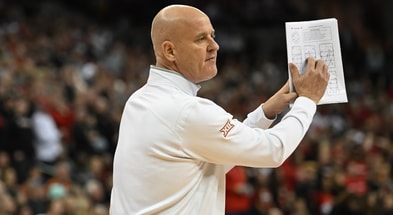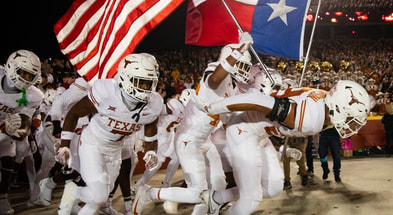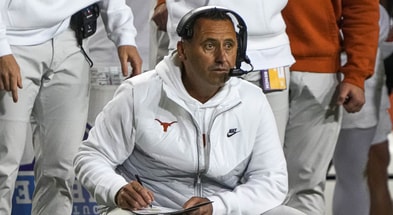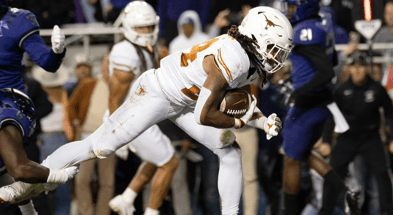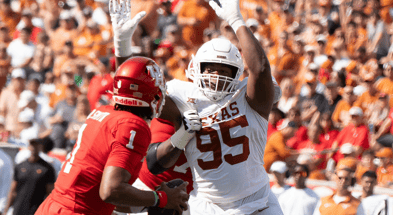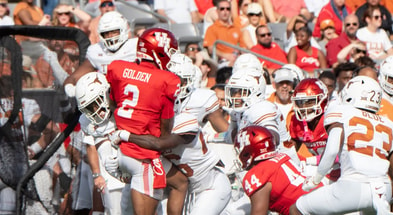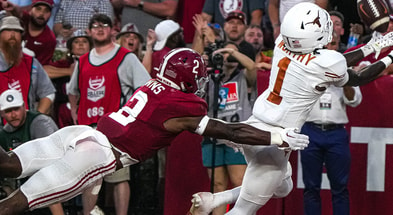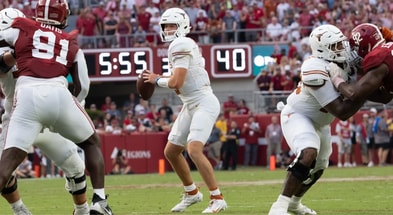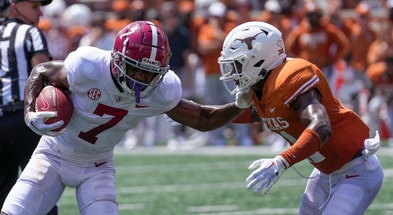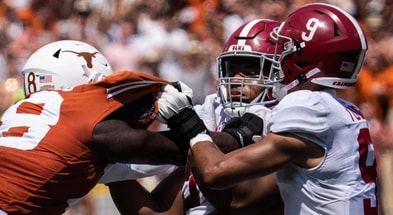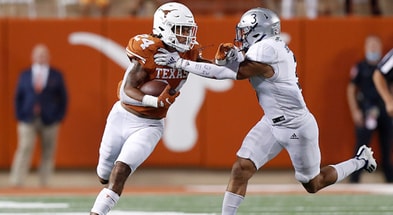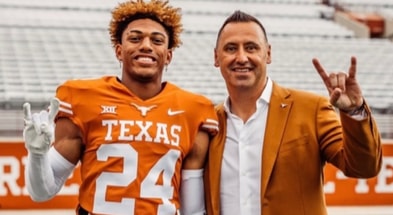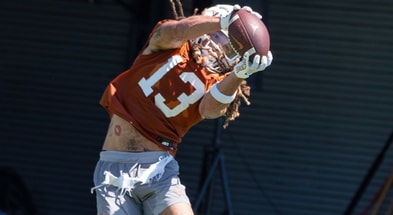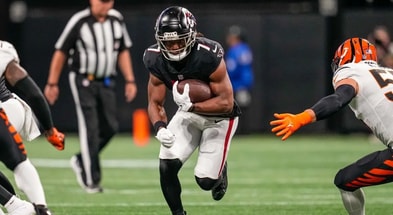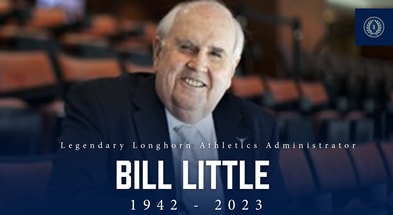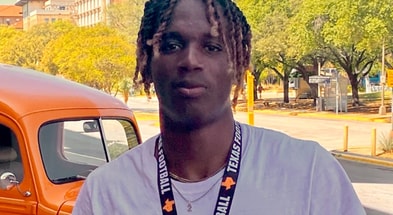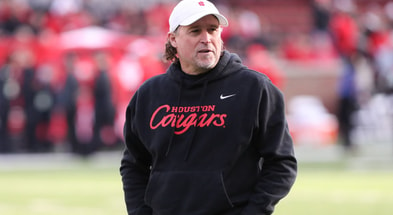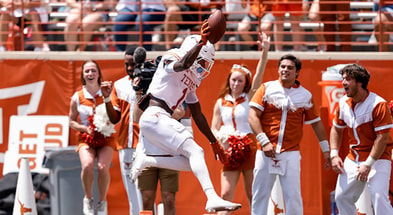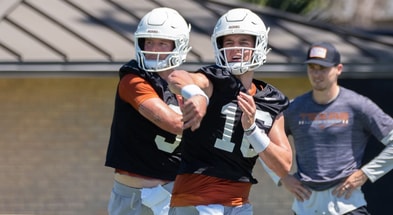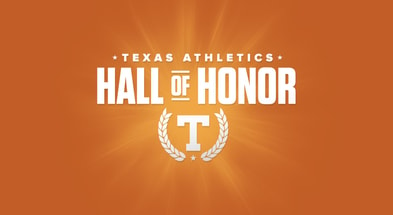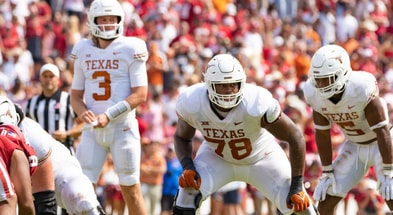Five quick thoughts: Slippage in Stillwater
Texas and Oklahoma State fought a war of attrition in Stillwater. Both teams had players beat up before the game or dropping during it and back-ups were flowing in from both benches.
[Get FOUR MONTHS of Inside Texas Plus for $1!]
Ultimately, Oklahoma State had a 4th year starter at quarterback and Texas had a redshirt freshman and each played like it.
Spencer Sanders zeroed in on Texas’ defenses, repeatedly beating the blitz and helping OSU convert four of five red zone trips with three touchdowns. On the day Sanders went 34-57 passing for 391 yards at 6.9 ypa with two touchdowns and one interception. He also added 11 carries for 43 yards, including some big scrambles which enabled scoring drives. Will he stay healthy carrying such a heavy load? No, but it didn’t matter today.
Quinn Ewers looked uncomfortable for the vast majority of the game, opening with an interception and finishing 19-49 for 319 yards at 6.5 ypa with two touchdowns to three interceptions. Texas couldn’t overcome that disparity (particularly when combined with other factors) and ultimately were beaten down over the course of this game.
The bye week comes at a great time for Texas to heal up and prepare for a back half of the season where the win to secure bowl eligibility is still uncollected and a single loss probably knocks them out of the Big 12 Championship hunt.
Quick thought no. 1: 16 targets for Xavier Worthy, four catches
One of Ewers’ big issues in this game was his reliance on Xavier Worthy, which Oklahoma State (naturally) figured out with time. On multiple snaps it seemed Ewers only had eyes for his star receiver, yet they could not connect due to miscommunications, errant tosses, and some heavy coverage shaded his way. With 16 targets Worthy’s way and only four catches for 78 yards and a score, the efficiency of Texas’ passing game was nearly crippled.
That’s 4.9 yards per target when throwing to Worthy, much worse than Texas’ numbers when involving the other receivers. One of the worst moments came on a 3rd down where Texas had three receivers to one side of the field all facing man coverage with no deep safety and Ewers made a sort of token look their way before turning to try and fire in a dig at the sticks to Worthy which was bracketed by senior safety Jason Taylor.
Worthy didn’t even extend for it and it’s hard to blame him, the ball sailed high over his head and a huge hit would have been coming had he a realistic shot. In a related story, Texas was 3-17 on 3rd down for the day.
This connection is one Texas has failed to effectively establish this season and will likely be a big point of emphasis in the bye week.
Quick thought no. 2: Texas’ secondary lost the war of attrition
Texas has some depth issues in the secondary, obviously.
They lost Ryan Watts again, who’s impact was apparent in moments such as his red zone interception when Oklahoma State tried to work the ball to Bryson Green.
Once Watts was out, Texas really struggled with the physicality of Green, who’s shockingly listed at only 6-foot-1, 205 pounds. He plays a lot bigger, like many Cowboy receivers before him. Green would eventually run through the Texas secondary for the winning touchdown and finished with five catches for 133 yards and the aforementioned score.
Losing Watts hurt but at least they had some solutions worked out for this eventuality. They played freshman Jaylon Guilbeau at nickel and moved Jahdae Barron back to cornerback, as they’d settled on against Iowa State. However they also lost Anthony Cook early in the game and eventually Guilbeau went down as well. Kitan Crawford had some bad coverage busts playing for Cook and eventually was pulled for Michael Taaffe, who played three different positions in this game. Jerrin Thompson was clearly playing through some issues from the Iowa State game and Texas was running out of answers on the back end as the game progressed.
Lack of assignment soundness from Crawford is an obvious issue for this team. He’s the most athletic safety on the team but if they can’t count on him to be in the right spots it doesn’t help them. The depth chart gets thin behind him at safety and Taaffe has to run around to plug holes with what’s probably 4.8 speed at best. He did a solid job but there are some obvious deficiencies when he has to cover a lot of space as a nickel or field safety, he’s at his best working in the boundary helping to direct traffic and delivering some big shots.
Texas had a great start to this game on 3rd down, mostly by playing some base quarters coverages. As the game wore on and Sanders lost a little something they mixed in more man coverage and shut the Pokes down in the 3rd quarter. Then the injuries piled up and eventually they were just hanging on for dear life, a good initial gameplan forgotten as they scrambled to patch holes.
Quick thought no. 3: Jeff Banks nearly delivered a win for Texas
At various points in this game Texas had an awful lot go right on special teams. They blocked a punt, they recovered a muffed punt, they avoided Oklahoma State pinning them on a few while they successfully pinned OSU.
Texas returned punts for 52 yards, including a Worthy return which set up a very short field (and a field goal). OSU had zero punt return yardage. Texas returned kicks for 109 yards, OSU had 61, and at various points Texas beat the touchback with long returns near midfield.
In the field goal game, Bert Auburn hit a pair of kicks and missed from 46 yards when they had a chance to take a late lead. OSU was also 2-for-3 in their own attempts.
There was a lot to suggest a major disparity in this game which should have taken its toll, but it did not. Texas’ struggles at quarterback and in the red zone (3-for-3 but with two field goals) were major factors. Another was penalties.
Texas was called for 14 penalties for 119 yards, many of them pretty harshly called on defensive pass interference or offensive holding.
Oklahoma State was called for zero penalties, a truly miraculous event the announcers hardly knew how to discuss.
Quick thought no. 4: Run game disparity
We knew Texas had advantages in the trenches in this game, it was really simply a matter of maximizing them and not allowing Sanders to outweigh them with his scrambling and throws into space.
Texas held the Cowboys to 142 rushing yards on 40 carries for an average of 3.6 ypc.
They had issues with the split zone and accompanying arc-read runs OSU loves on the goal line, which lead to Dominic Richardson managing a line of 13 carries for 24 yards at 1.8 ypc and three touchdowns. Split zone beat them badly on a 51-yard run by Jaden Nixon as well. Beyond that and a scramble or two from Sanders, Texas defended the run very well once again.
Meanwhile the Longhorns ran the ball 32 times for 204 yards at 6.4 ypc and two touchdowns. Bijan Robinson looked like he was going to put up a Heisman game early on and still finished with 24 carries for 140 yards at 5.8 ypc and a score while also catching one ball for 41 yards and another score.
Roschon Johnson added five carries for 73 yards and a touchdown. Texas just couldn’t get into the run game playbook often enough due to the disastrous nature of the passing game which routinely put them behind the chains.
Early on they were also crushing Oklahoma State with counter runs from 12 personnel, run to the weak side of the formation. Eventually the Cowboys started spilling the pulling blocker better and Texas’ tight ends struggled to lead around the edge, leading to some stuffed runs. They also loaded the box more and more aggressively as the game wore on, like Texas was facing back in 2021.
Late in the game Texas almost imposed their will by forcing some runs only for a few incompletions to Worthy to derail another drive and lead to the missed field goal.
Quick thought no. 5: Growing pains…
Quinn Ewers’ amazing arrival on the scene in college football was obscured early on by a few key factors.
His opener against ULM was solid but flawed, much like you’d expect from a first-year signal-caller. Then he had a fantastic opening against Alabama, executing a script they’d probably practiced all offseason, before leaving with injury. Ewers then had several weeks to practice before taking the field against Oklahoma with another well prepared gameplan against a team lacking a quarterback to oppose him. He was good, not necessarily dominating but certainly making several eye-popping throws.
Since then, Ewers has come back down to earth. This was his first road game in the Big 12 and the pressure of the moment was clearly getting to him. He struggled to step up in the pocket, get through progressions, or even deliver accurate balls in rhythm.
When executing more Southlake Carroll-esque 4-verticals concepts down the stretch he looked more comfortable than any previous point in the game and zipped in some throws that almost made it interesting. The idea of using that concept to find Ja’Tavion Sanders up the seam is one they should explore more this season. I heard from someone who attended the game live who was ultimately impressed by Ewers’ ability to keep coming after them and making several throws into whipping winds late.
Ultimately this will go down as a painful lesson for Ewers in what it’s like to face a smart opposing team on the road in a very hostile atmosphere where it seems the fans, officials, and even the wind are against you.
You have to grit these games out with high-IQ play and physical toughness. It’s a lesson quarterbacks generally learn with experience, experience Ewers still lacks.
Texas has a bye week to try and get him more comfortable again, figure out the Worthy connection, and rebuild the secondary before a big final stretch.
